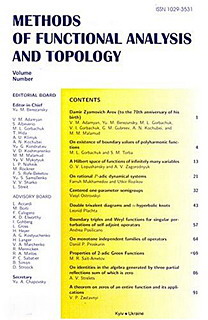I. Ya. Ivasiuk
Search this author in Google Scholar
Inverse spectral problem for some generalized Jacobi Hermitian matrices
MFAT 15 (2009), no. 4, 333-355
333-355
In this article we will investigate an inverse spectral problem for three-diagonal block Jacobi type Hermitian real-valued matrices with "almost" semidiagonal matrices on the side diagonals.
Direct spectral problem for the generalized Jacobi Hermitian matrices
MFAT 15 (2009), no. 1, 3-14
3-14
In this article we will introduce and investigate some generalized Jacobi matrices. These matrices have three-diagonal block structure and they are Hermitian. We will give necessary and sufficient conditions for selfadjointness of the operator which is generated by the matrix of such a type, and consider its generalized eigenvector expansion.
Recursion relation for orthogonal polynomials on the complex plane
Yu. M. Berezansky, I. Ya. Ivasiuk, O. A. Mokhonko
MFAT 14 (2008), no. 2, 108-116
108-116
The article deals with orthogonal polynomials on compact infinite subsets of the complex plane. Orthogonal polynomials are treated as coordinates of generalized eigenvector of a normal operator $A$. It is shown that there exists a recursion that gives the possibility to reconstruct these polynomials. This recursion arises from generalized eigenvalue problem and, actually, this means that every gene alized eigenvector of $A$ is also a generalized eigenvector of $A^*$ with the complex conjugated eigenvalue. If the subset is actually the unit circle, it is shown that the presented algorithm is a generalization of the well-known Szego recursion from OPUC theory.
Generalized selfadjoinness of differentiation operator on weight Hilbert spases
MFAT 13 (2007), no. 4, 333-337
333-337
We consider examples of operators that act in some Hilbert rigging from positive Hilbert space into the negative one. For the first derivative operator we investigate a ``generalized'' selfadjointness in the sense of weight Hilbert riggings of the spaces $L^2([0,1])$ and $L^2(\mathbb{R})$. We will show that an example of the operator $i \frac{d}{dt}$ in some rigging scales, which is selfadjoint in usual case and not generalized selfadjoint, can not be constructed.

